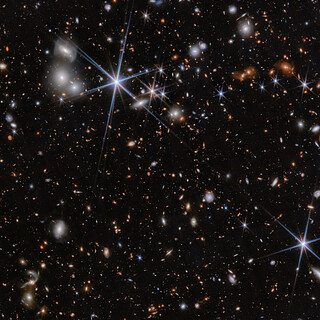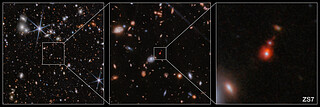weic2413 — Science Release
Webb detects most distant black hole merger to date
16 May 2024
An international team of astronomers have used the NASA/ESA/CSA James Webb Space Telescope to find evidence for an ongoing merger of two galaxies and their massive black holes when the Universe was only 740 million years old. This marks the most distant detection of a black hole merger ever obtained and the first time that this phenomenon has been detected so early in the Universe.
Astronomers have found supermassive black holes with masses of millions to billions times that of the Sun in most massive galaxies in the local Universe, including in our Milky Way galaxy. These black holes have likely had a major impact on the evolution of the galaxies they reside in. However, scientists still don’t fully understand how these objects grew to become so massive. The finding of gargantuan black holes already in place in the first billion years after the Big Bang indicates that such growth must have happened very rapidly, and very early. Now, the James Webb Space Telescope is shedding new light on the growth of black holes in the early Universe.
The new Webb observations have provided evidence for an ongoing merger of two galaxies and their massive black holes when the Universe was just 740 million years old. The system is known as ZS7.
Massive black holes that are actively accreting matter have distinctive spectrographic features that allow astronomers to identify them. For very distant galaxies, like those in this study, these signatures are inaccessible from the ground and can only be seen with Webb.
“We found evidence for very dense gas with fast motions in the vicinity of the black hole, as well as hot and highly ionised gas illuminated by the energetic radiation typically produced by black holes in their accretion episodes,” explained lead author Hannah Übler of the University of Cambridge in the United Kingdom. “Thanks to the unprecedented sharpness of its imaging capabilities, Webb also allowed our team to spatially separate the two black holes.”
The team found that one of the two black holes has a mass that is 50 million times the mass of the Sun. “The mass of the other black hole is likely similar, although it is much harder to measure because this second black hole is buried in dense gas,” explained team member Roberto Maiolino of the University of Cambridge and University College London in the United Kingdom.
“Our findings suggest that merging is an important route through which black holes can rapidly grow, even at cosmic dawn,” explained Übler. “Together with other Webb findings of active, massive black holes in the distant Universe, our results also show that massive black holes have been shaping the evolution of galaxies from the very beginning.”
"The stellar mass of the system we studied is similar to that of our neighbor the Large Magellanic Cloud," shared team member Pablo G. Pérez-González of the Centro de Astrobiología (CAB), CSIC/INTA, in Spain. "We can try to imagine how the evolution of merging galaxies could be affected if each galaxy had one super massive black hole as large or larger than the one we have in the Milky Way".
The team also notes that once the two black holes merge, they will also generate gravitational waves [1]. Events like this will be detectable with the next generation of gravitational wave observatories, such as the upcoming Laser Interferometer Space Antenna (LISA) mission, which was recently approved by the European Space Agency and will be the first space-based observatory dedicated to studying gravitational waves.
“Webb’s results are telling us that lighter systems detectable by LISA should be far more frequent than previously assumed,” shared LISA Lead Project Scientist Nora Luetzgendorf of the European Space Agency in the Netherlands. “It will most likely make us adjust our models for LISA rates in this mass range. This is just the tip of the iceberg.”
This discovery was from observations made as part of the Galaxy Assembly with NIRSpec Integral Field Spectroscopy programme. The team has recently been awarded a new Large Programme in Webb’s Cycle 3 of observations, to study in detail the relationship between massive black holes and their host galaxies in the first billion years. An important component of this programme will be to systematically search for and characterise black hole mergers. This effort will determine the rate at which black hole merging occurs at early cosmic epochs and will assess the role of merging in the early growth of black holes and the rate at which gravitational waves are produced from the dawn of time.
These results have been published in the Monthly Notices of the Royal Astronomical Society.
Notes
[1] Gravitational waves are invisible ripples in the fabric of spacetime. Spacetime is a four-dimensional quantity, described by Einstein’s general theory of relativity, which fuses three-dimensional space with time. Mass warps spacetime, and gravity is actually the result of spacetime being curved by an object’s mass. Ripples through spacetime are created by the movement of any object with mass, and these are known as gravitational waves. Gravitational waves are constantly passing unnoticed through Earth and they are caused by some of the most violent and energetic events in the Universe. These include colliding black holes, collapsing stellar cores, merging neutron stars or white dwarf stars, the wobble of neutron stars that are not perfect spheres and possibly even the remnants of gravitational radiation created at the birth of the Universe.
More information
Webb is the largest, most powerful telescope ever launched into space. Under an international collaboration agreement, ESA provided the telescope’s launch service, using the Ariane 5 launch vehicle. Working with partners, ESA was responsible for the development and qualification of Ariane 5 adaptations for the Webb mission and for the procurement of the launch service by Arianespace. ESA also provided the workhorse spectrograph NIRSpec and 50% of the mid-infrared instrument MIRI, which was designed and built by a consortium of nationally funded European Institutes (The MIRI European Consortium) in partnership with JPL and the University of Arizona.
Webb is an international partnership between NASA, ESA and the Canadian Space Agency (CSA).
Image Credit: ESA/Webb, NASA, CSA, J. Dunlop, D. Magee, P. G. Pérez-González, H. Übler, R. Maiolino, et. al
Links
Contacts
Hannah Übler
Kavli Institute for Cosmology & Cavendish Laboratory, University of Cambridge
United Kingdom
Email: [email protected]
Bethany Downer
ESA/Webb Chief Science Communications Officer
Email: [email protected]
Ninja Menning
ESA Newsroom and Media Relations Office
Email: [email protected]
About the Release
| Release No.: | weic2413 | |
|---|---|---|





